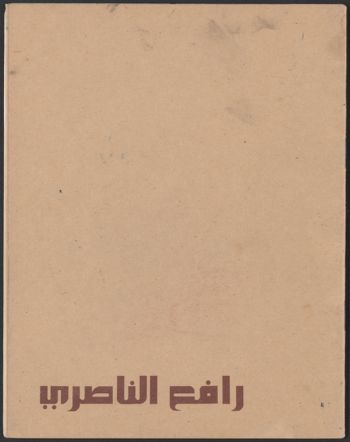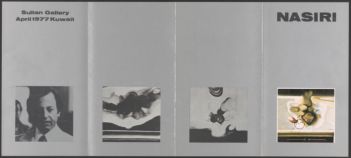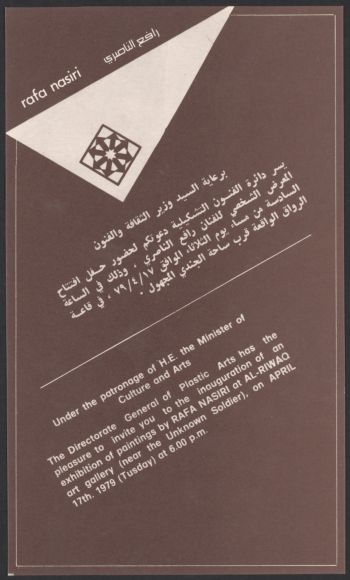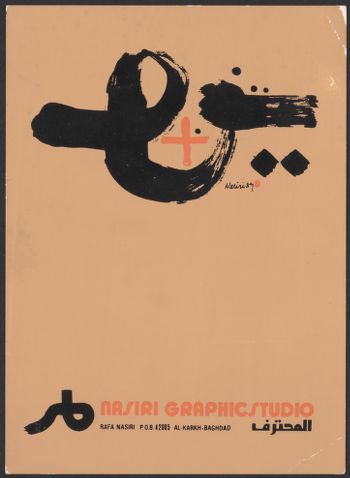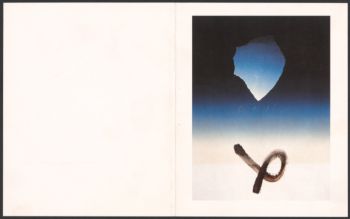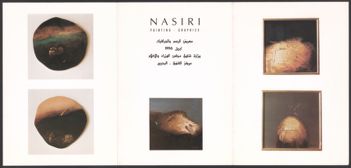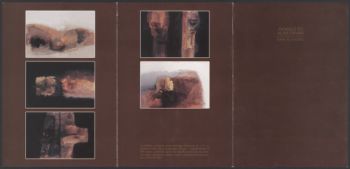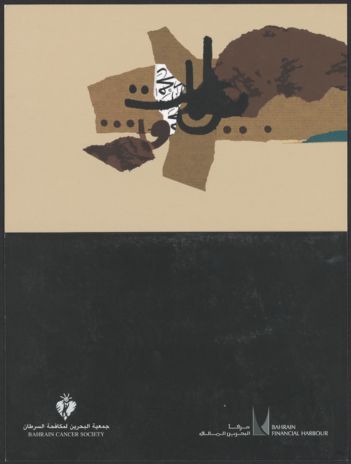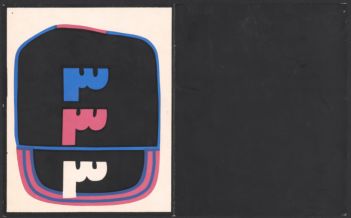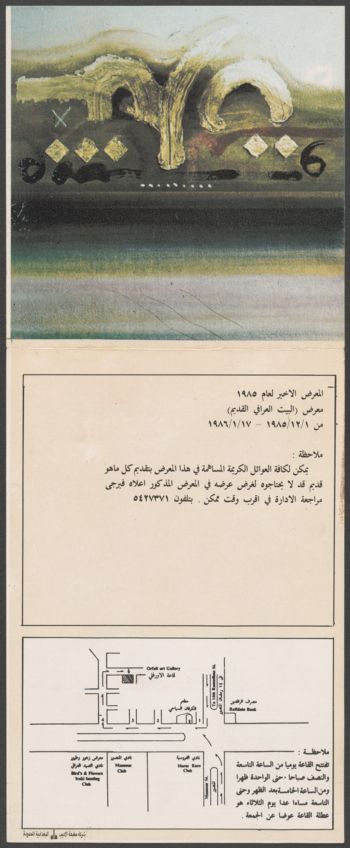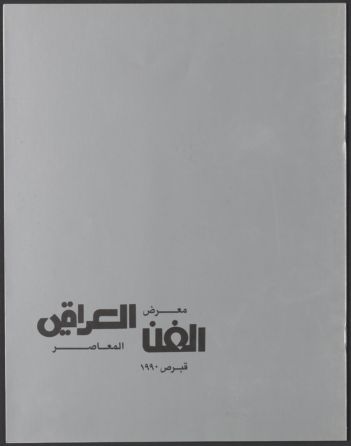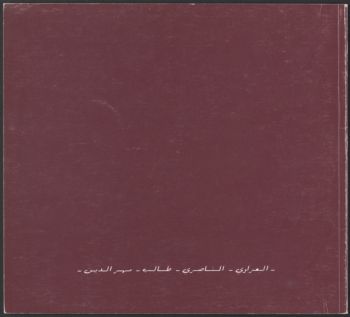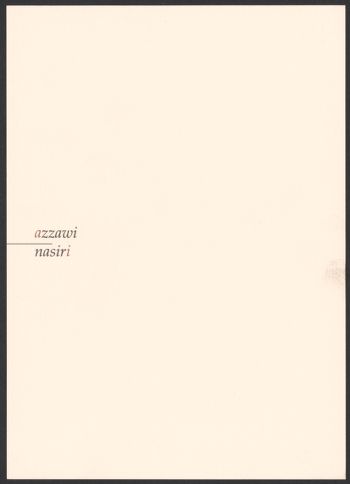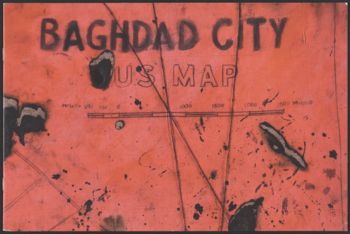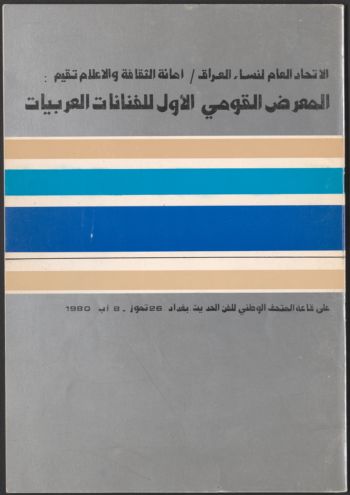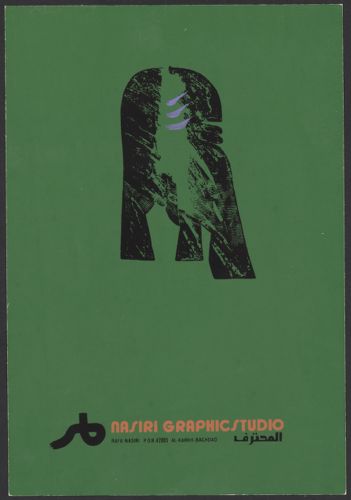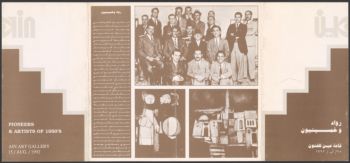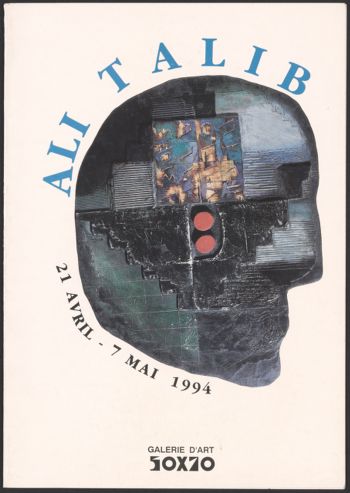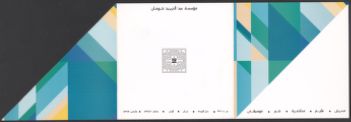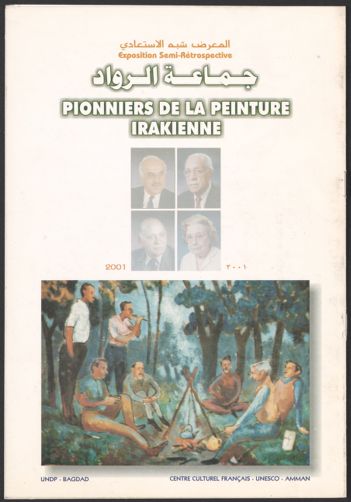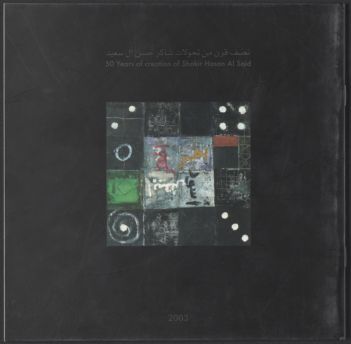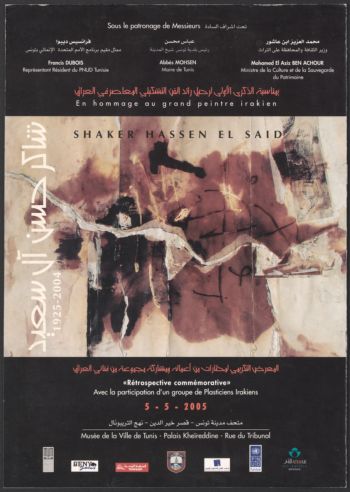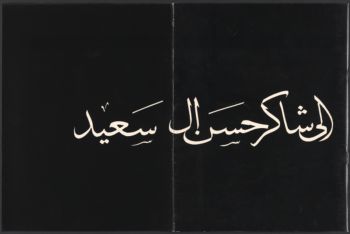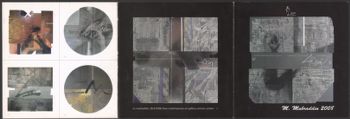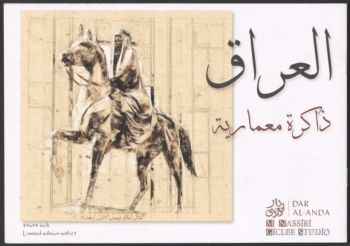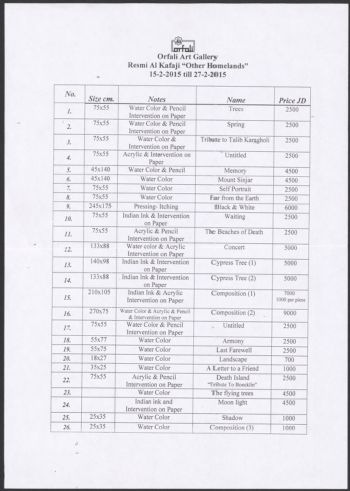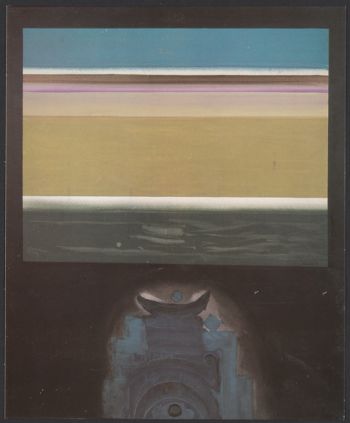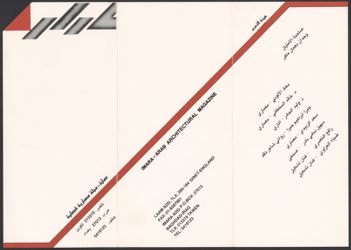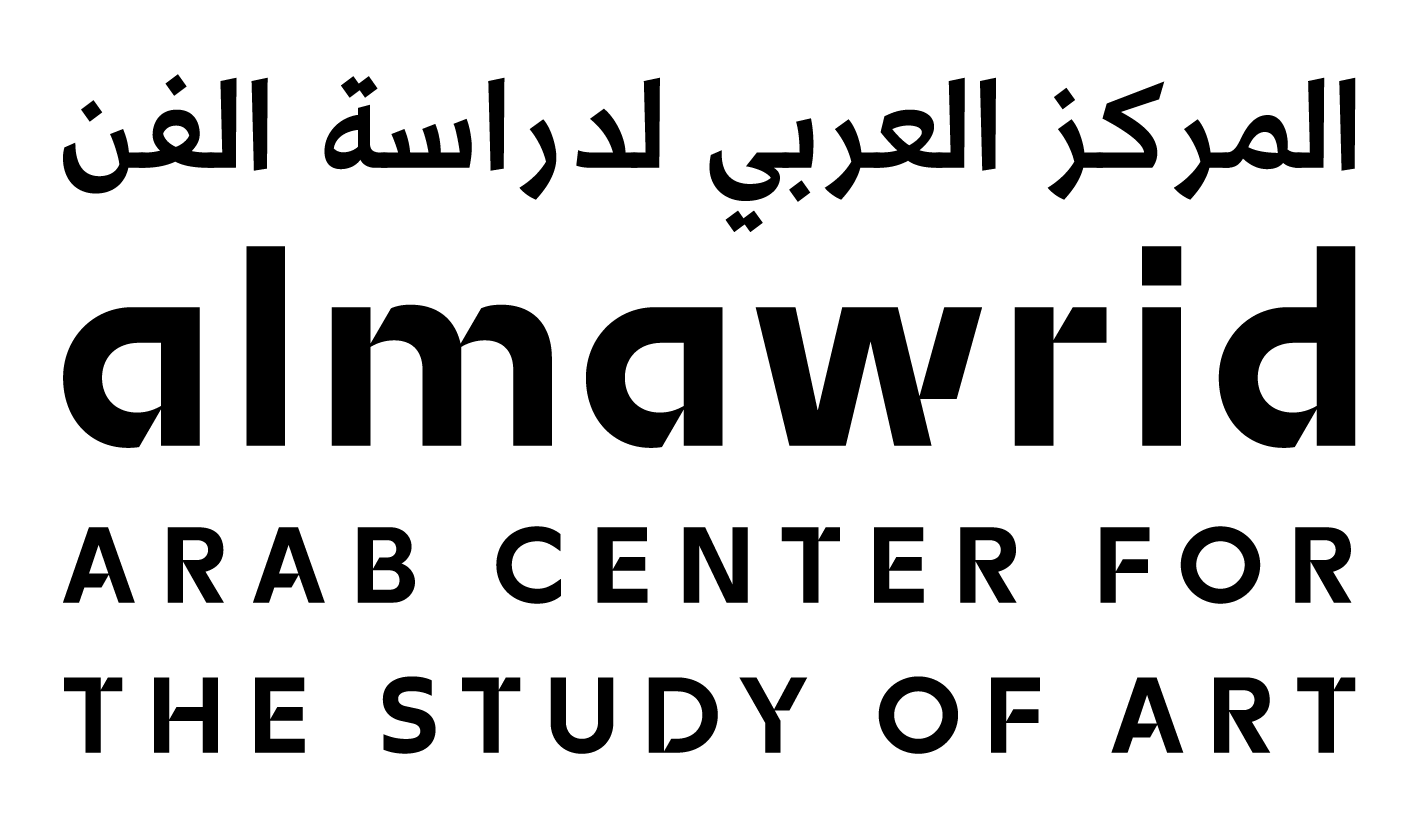Rafa Nasiri and May Muzaffar Collection
Call Number
Date
Creator
Extent
Condition Description
Language of Materials
Abstract
The collection includes personal papers, correspondence, writing, journals, exhibition materials, photographs, and documentation belonging to Iraqi artist Rafa Nasiri (1940–2013) and Iraqi poet and critic May Muzaffar (1940–), a married couple. They were assembled throughout the couple's life together, and later organized by Muzaffar. Rafa Nasiri was born in Tikrit in 1940. He studied at the Institute of Fine Arts, Baghdad, followed by the Central Academy of Fine Arts, Beijing. A creative and accomplished printmaker, Nasiri received several scholarships to support further study in Europe as well. He played a central role in Iraqi modern art developments, including co-founding the New Vision Group (1969), as well as the advancements of printmaking across the Arab world. Nasiri founded and headed the printing workshop at the Institute of Fine Arts in Baghdad from 1974 until his retirement in 1989. From the mid-1980s until 1991, he maintained a Graphic Studio, "Al Muhtaraf," in Al Mansour neighborhood that presented exhibitions and became a gathering place for events. Nasiri and Muzaffar left Iraq in 1991 for Jordan. Between 1991 and 1997, Nasiri taught painting, printmaking and design at the University of Yarmouk in Irbid, Jordan, then held the position of lecturer at the University of Bahrain and director of the Bahrain Center for the Fine Arts and Tradition. Returning to Amman in 2003, Nasiri battled prostate cancer while maintaining a prolific artistic output, completing notable series like Homage to al-Mutanabi and Homage to Ibn Zaydoun. Rafa Nasiri passed away in Amman in 2013. May Muzaffar was born in Baghdad in 1940. She is a poet, short-story writer, critic, editor, and translator. A prolific and knowledgeable writer on topics of art and culture in Iraq, she helped to shape the Baghdad art scene. A collection of Muzaffar's essays were published in Modern Art in Iraq: Continuity and Differentiation (2015) and she served as an editor for the Bahraini literary journal Thaqafat (co-edited with Nasiri). Other books include Rafa and I: A Story of Water and Fire (2021) [in Arabic] , which has now been published in English translation as Story of Water and Fire (Berlin: al Mawrid Arab Center for the Study of Art and Hatje Cantz, 2023). She has written numerous volumes devoted to analysis of the work of Rafa Nasiri, including Rafa Nasiri: 50 Years of Printmaking (2013).
Biographical notes
Rafa Nasiri (1940–2013) is considered one of the most influential Iraqi artists of the twentieth century, due to his international experience and experimental interest in material techniques across painting, printmaking, graphic design, and book arts. Nasiri was a central participant in numerous Iraqi and Arab artists' groups and initiatives, among them the New Vision group (est. 1969) and the One Dimension group (est. 1970s). He is celebrated for deriving strategies from East Asian arts for incorporating Arabic calligraphic forms into his paintings and prints in elegantly modern ways. Later in his career, Nasiri undertook a sustained interest in making art books as a medium.
Rafa Nasiri was born in Tikrit in 1940. He graduated from the Institute of Fine Arts, Baghdad, with a diploma in painting in 1959. In his last year of study, he was drawn to a collection of watercolors and Chinese ink prints from an exhibition of Chinese antiques and masterpieces on display in the main hall of the Institute. From 1959 to 1963, Rafa Nasiri moved to Beijing to study printmaking at the Central Academy of Fine Arts. Among his teachers was Huang Yu Yi, who taught Nasiri the traditional ways of applying color, and trained him on accuracy, speed and attention in printmaking. The teacher also shared with the artist the latest art books and magazines that arrived from Hong Kong, and that would allow them both to follow the art trends of the West while being in close contact with the contemporary Chinese art at the time. Throughout the years of his study, and until graduation from Beijing with a Bachelor of Arts, Nasiri exchanged letters and postcards with his family in Baghdad. Much of this correspondence survives in his archive today. In the summer of 1965, Rafa Nasiri went on a two-month road trip with two of his brothers, in which they visited twenty-four Arab and European countries. The artist came into direct contact with Western art at museums and other locations that can be traced in his slide collection of photographs taken during the trip. He also visited Museo del Prado, the Louvre, the British Museum, and Rijksmuseum in Amsterdam, which allowed him to see paintings by Velasquez, Goya, and El Greco, Rubens, Rembrandt, Turner and the expressionists in person. In 1964, Nasiri joined the faculty of the Institute of Fine Arts in Baghdad. A couple of years later, Nasiri received a scholarship from The Gulbenkian Foundation to study at The Gravura, in Lisbon, Portugal, where he received a diploma in printmaking. In his collection are photos taken with his colleagues Hashim Samarchi and Salim Al Dabbagh of their participation in the 1968 graphic art exhibitions at The Gravura.
He returned to Baghdad in the aftermath of the defeat of the Arabs in the 1967 Arab-Israeli War. In response to this major setback, he and colleagues Dia al-Azzawi, Ismail Fattah, Mohammed Muhreddin, Hashim Samarchi, and Saleh al-Jumaie co-founded the New Vision Group in Baghdad in 1969 and issued a manifesto. The collection includes photographs of the group's exhibition at Baghdad's Museum of Modern Art, also known as the Gulbenkian Hall.
A two-year relationship with the emerging poet and art critic May Muzaffar culminated in marriage on the final day of 1973. They started traveling together, and Muzaffar accompanied Nasiri to his artist residencies including to his training at the International Summer Academy in Salzburg in 1974-1975. Nasiri also built a printing press for his own use and moved it to his house in Baghdad, eventually dedicating a space of its own for the press that could also be used by other artists. Rafa Nasiri's Graphic Studio, "Al Muhtaraf," was located in Al Mansour neighborhood from mid 1980s until 1991.
In 1974, Rafa Nasiri founded the Graphic Department at the Institute of Fine Arts, which he directed until his retirement in 1989. In 1991, Nasiri accepted an invitation to teach at Yarmouk University in Irbid, Jordan, located 95 km north of the capital Amman, and the couple left Iraq. Nasiri and Muzaffar lived in Irbid but Nasiri kept a studio in Amman, he also taught printmaking at Darat al Funun in Amman. During this decade, many Iraqi artists including Shakir Hassan Al Said and Ali Taleb were active in the Jordanian scene. Nasiri's views on their activities are included in his memoirs.
In addition to teaching graphic arts and design, Nasiri traveled to participate in exhibitions and events around the world, earning prizes from the International Graphic Biennial, Fredrikstad (1978) and Baghdad Festival of Arts (1986), among others. He also served as jury member in major art events such as the Third World Biennial of Graphic Art, London (1980), Intergrafik, Berlin (1987), International Graphic Triennial, Fredrikstad (1995), and International Graphic Triennial in Cairo (1997). Beginning with the first iteration of the Cultural Moussem of Asilah in Morocco, in 1978, Nasiri and Muzaffar regularly attended and contributed to the building of the printmaking studio in this annual gathering of artists. Materials in the collection document the rich art and literary encounters in Asilah as well as the extended trips the couple made in the region.
Between 1997 and 2003, Nasiri took a new position as lecturer at the University of Bahrain in Manama, where he was also the director of the Bahrain Center for the Fine Arts and Tradition. There he started his series Homage to al-Mutanabi, a series of paintings on canvas and paper, prints, and also artist books produced over several years.
In 2003, Nasiri and Muzaffar returned to Amman and settled in a flat in Jabal Amman with a studio in Jabal al Weibdeh , known as an arts-rich neighborhood. In 2009, Nasiri was diagnosed with prostate cancer, yet he continued to work through his chemotherapy treatment. Among the works he completed in this phase was a collection titled Homage to Ibn Zaydoun. His final exhibitions were two retrospectives in 2013: 50 Years of Painting and Printmaking at the Jordan National Gallery for Fine Arts, Amman, and another at The Financial Harbour Art Gallery, Manama. His authored books include Horizons and Mirrors (2005) and My Journey to China (2012).
Nasiri passed away in Amman in 2013.
May Muzaffar (1940– ) is a poet, short-story writer, critic, editor, and translator. She was born in Baghdad in 1940. Muzaffar studied English Literature at the University of Baghdad and pursued additional studies in Arabic language with prominent religious and literary figures in Baghdad before forging close friendships with key literary figures of the time such as Najib al-Maniʿ, Nizar Qabbani, and Ferial Ghazoul. While starting her career in an insurance company, Muzaffar self-developed skills in oral recitation of poetry and in criticism. She was an active member of Baghdad's art scene. Her poetry books include Nocturnes (1994), Mail from the Orient (2003), and Absence (2014). She translated several books into Arabic that are related to literature and art, including Etel Adnan's novel Paris When It's Naked. A collection of her essays were published in Modern Art in Iraq: Continuity and Differentiation (2015) and she has served as a contributing editor to the Bahraini literary journal Thaqafat. Other books include Anā wa-Rāfiʻ al-Nāṣirī: Sīrat al-Māʼ wa-al-Nār (2021), which was published in English translation as Story of Water and Fire (Berlin: al Mawrid Arab Center for the Study of Art and Hatje Cantz, 2023). She has written numerous volumes devoted to analysis of the work of Rafa Nasiri including Rafa Nasiri: 50 Years of Printmaking (2013). Muzaffar continues to live in Amman, Jordan, and manages Rafa Nasiri Studio in Jabal al Weibdeh, and the annual Rafa Nasiri Graphic Arts Award which honors Rafa's art and life achievements. She maintains the website of Rafa Nasiri and publishes some documentation of his work http://rafanasiri.com.
Arrangement
The collection is arranged in the following series: (I) Personal papers; (II) Correspondence; (III) Writings; (IV) Exhibition materials (V) Photographic Prints; (VI) Photographic Slides; (VII) Designs by Rafa Nasiri; (VIII) Other items in the possession of the artist.
Content Description
The Rafa Nasiri (1940–2013) and May Muzaffar (1940– ) Collection contains archival materials including correspondence, postcards, writings, exhibition materials, and photographs assembled over the duration of Nasiri's professional life as an artist and Muzaffar's professional life as a writer. The couple are two of Iraq's most prominent cultural figures in the second half of the 20th and early 21st centuries. Having married on December 31, 1973, Nasiri and Muzaffar lived together in Baghdad until 1991 before moving to Jordan, then to Bahrain in 1997, and back again to Jordan in 2003. The collected materials reflect nearly three decades of formative activities in Iraq as well as subsequent initiatives and projects outside the country. What stands out is Nasiri's prolific production, which is evident in the volume of journals, photographs, and letters as well as exhibition materials (brochures, invites, books, correspondence) from the 1960s until his passing in 2013. Highlights include a unique set of journals, handwritten and illustrated by Rafa Nasiri over a long period, 1976-2003, that detail information about and responses to the personal and professional events as well as practical details of his life. These journals include information on the practical details related to finances, residency permits, commuting costs, feelings of despair, hope, restlessness, as well as notes on students, peers and bureaucrats.
The Collection also contains documents pertaining to the work of poet and art critic Muzaffar, including brochures, invites, press clippings, books, correspondence related to Iraqi art and literary scenes from the 1960s until today. Also represented are numerous photographs documenting artists' gatherings, events, trips and travels from 1963 until 2013. There are several sets of 35mm slides taken by Rafa Nasiri for purposes of documenting or teaching, some of the photographs show trips to heritage sites in Iraq or the artist's several trips to Asilah (Morocco) as well as Germany, Portugal, Spain and China. Most of these trips were taken with Muzaffar, who is present in the images.
Noteworthy aspects of the multifaceted career of Nasiri include his role as a teacher and his founding contributions to many art institutions. Photographs of Rafa Nasiri at the Institute of Fine Arts in Baghdad, where he taught from 1964 to 1989 show the confidence and rootedness he enjoyed as an established figure of the Iraqi art scene. Images from these active years include formative events such as a poster exhibition and the Institute's first graphic art graduates' exhibition in 1977. The collection holds documents from Nasiri's extensive travels, residencies, and collaborations with fellow artists and institutions, showcasing his impact on the regional art landscape. Co-maintained by Nasiri's life-partner Muzaffar, the collection holds details about their shared experiences, friendships, and artistic endeavors.
Subjects
Organizations
People
Topics
Conditions Governing Access
Digital surrogates only are held by the repository. Based on the agreement with the owner, digital images of selected series/subseries will be publicly available on the NYU Archival Collections Finding Aid Portal. Materials not made available online may be consulted in person at al Mawrid, NYUAD. Researchers should contact nyuad.almawrid@nyu.edu to request details or to make an appointment.
Conditions Governing Use
Intellectual property rights for the Rafa Nasiri and May Muzaffar collection remain with May Muzaffar. al Mawrid Arab Center for the Study of Art does not hold any legal rights over the content of its collections, and therefore cannot grant legal rights to anyone who wishes to publish material. Copyright status has not been determined for all collection items. It is the responsibility of the researcher to clear the rights from the respective copyright holders. All use permissions must be sought from May Muzaffar, through a request submitted to al Mawrid Arab Center for the Study of Art at nyuad.almawrid@nyu.edu.
Preferred Citation
Title or identification of item, date when known, Rafa Nasiri and May Muzaffar Collection, ADMC092, item identifier (Ref. number). Arab Art Archive, al Mawrid Arab Center for the Study of Art, New York University Abu Dhabi.
Existence and Location of Originals
Original materials are with May Muzaffar in Rafa Nasiri's Studio in Jabal al Weibdeh, Amman, Jordan.
Immediate Source of Acquisition
The materials were digitized in batches between January 2022 and January 2024. All materials were returned to the owner upon digitization. Further batches are planned to be digitized in 2024.
Custodial History
The materials were created or collected by two of Iraq's most prominent cultural figures of the late 20th and early 21st centuries, the artist Rafa Nasiri (1940-2013) and the poet and art critic May Muzaffar (b. 1940). The earliest materials date from the 1940s, and continue through their marriage of 40 years between 1974 and 2013.
When Nasiri and Muzaffar left Baghdad in 1991, they did not take their archive, books, or art collections, but instead entrusted a guard to take care of their house and studio. The guard was killed in 2006 during the sectarian violence that followed the fall of Baghdad in 2003. A war-displaced person was employed to maintain the house, but eventually, they had to sell the house and studio in 2013. They sought the help of artist friend Khalid Wahal to move as many documents as possible in batches, shipped in cardboard boxes to Amman with drivers from Baghdad. The majority of the books in their library were given away to acquaintances in Baghdad.
The transported materials, as well as other materials that the couple accumulated in Jordan and Bahrain since 1991, are in the possession of poet and art critic May Muzaffar (b. 1940) as custodian of the estate. Since Nasiri passed away on December 7, 2013, Muzaffar has been organizing, scanning, cataloging and publishing Nasiri's archive including his studies and letters. The collection is kept in her office which was the late artist's studio in Jabal al Weibdeh in Amman, Jordan. The studio also holds Nasiri's paintings and prints, as well as his personal journals, artist books, photographs, and sketchbooks, all of which are inherited and now owned by Muzaffar.
In 2021, al Mawrid's researchers visited May Muzaffar's office and she agreed to loan the collection for digitization, cataloging and publishing as part of the Arab Art Archive. Since January 2022, al Mawrid has been receiving the materials in batches and returning them to Muzaffar after digitization and cataloging.
Bibliography
About this Guide
Processing Information
The collection was processed by the team of al Mawrid Arab Center for the Study of Art, 2022–2024, including Ala Younis, Ibrahim Mohamed Ali, Dina Taha, Anneka Lenssen, Jonathan Burr, Maysa Shaer, and Jasmine Soliman.
Prior to digitization, the physical materials were arranged according to format and subject. Documents pertaining to teaching performance and work at the Institute of Fine Arts in Baghdad are contained in a thread-bound folder, arranged chronologically. Letters and postcards are housed in envelopes and plastic envelopes and arranged per sender or addressee. Photographs are kept in paper envelopes, some of which feature the name and address of the studio that developed their negatives, mostly in Baghdad. The photographic slides are in plastic containers with instances of tagging or annotation handwritten on the external plastic cover. Designs, cards, and exhibition materials are housed in plastic enclosures. Nasiri's diaries take the form of individual notebooks, inscribed and illustrated by the artist.
On the whole, the organization of the digitized collection reflects the arrangement of the materials as kept in Nasiri Studio and maintained by Muzaffar. For example, Series II, Correspondence, may contain postcards addressed to family and friends side-by-side with unused, empty postcards and design cards (as reflects how the materials are physically arranged in the Studio). In some instances, al Mawrid researchers opted to rearrange photographs, photographic slides, postcards, and letters once they were identified as belonging to the same topic, journey, or person. This rearrangement was to avoid the fragmentation of the series and was agreed on with the owner of the collection. In the case of photographic slides, some identification was given on the plastic sleeves and captions, and the information was incorporated into the collection arrangement. Arab Art Archive finding aids are prepared in both English and Arabic. Researchers seeking to confirm the Arabic spelling of an artist's name are encouraged to consult the Arabic finding aid. In the English-language finding aids, transliterations of Arabic names are guided by al Mawrid policy to use the artist's preferred professional spelling whenever possible. Spellings are checked against artist websites or social media presence (when existent) as well as any available government documents such as a passport or ID. In the case when no such primary documents may be found, spellings are checked with Library of Congress Name Authority File; academic sources such as Modern Art in the Arab World: Primary Documents; Getty Vocabularies / Union List of Artist Names; and in some cases Mathaf Encyclopedia of Modern Art and the Arab World. Al Mawrid Arab Center for the Study of Art maintains an internal Name Standardization Reference List with notes about authoritative sources.
In the case of the Rafa Nasiri and May Muzaffar Collection in particular, for ease of cross-reference, we have sometimes opted to spell names in accordance with the transliterations used in Story of Water and Fire, trans. Jennifer Peterson (Berlin: al Mawrid Arab Center for the Study of Art and Hatje Cantz, 2023). Rather than transliterate Arabic-language titles of documents for the purposes of the English-language finding aid, it was decided for consistency and ease to translate Arabic titles, as well as titles in other languages, into English. Translated titles and phrases are placed inside square brackets.
Repository
Container
Series I : Personal Papers
Scope and Contents
This series includes Rafa Nasiri's personal papers, identification cards, reports and official work documents and reports related to his teaching years at the Institute of Fine Arts in Baghdad.
I.A. Membership and Identity Cards
Scope and Contents
Membership cards issued by different institutions, including the Iraqi Artists Syndicate issued to Rafa Nasiri in 1985.
I.B. Academic Records
Scope and Contents
Originally consolidated in a thread-bound volume labeled with the name Rafa Kamel Nasiri, these documents comprise a human resources file at the Institute of Fine Arts in Baghdad. Includes evaluations of Rafa Nasiri's teaching performance, invitations, requests to travel, history of vacations, and salary information.
I.C. Financial Records and Payslips
Scope and Contents
Documents related to payments that were issued or received by Rafa Nasriri while he was living in Baghdad.
Series II: Correspondence
Scope and Contents
This series features a large volume of professional correspondence directed to Rafa Nasiri at his Institute of Fine Arts address in Baghdad, as well as postcards and letters, exchanged with artists, writers, and family members, among them letters Nasiri sent to his father and brothers during his years in Beijing.
II.A. Correspondence with Family
Scope and Contents
Includes letters and postcards exchanged between Nasiri and his father, 1960–1979, and with his brothers, including Sofian Nasiri, Talal Nasiri, Munir Nasiri, and Sabah Nasiri, 1961–1963; letters exchanged between May Muzaffar and Rafa Nasiri, 1973 and 1996, including a set exchanged via Fax during their time in Bahrain, and a set exchanged while in Cairo in 1996.
II.B. Correspondence with Friends, Colleagues, Students, and Institutions
Scope and Contents
Includes letters exchanged with Arab artists, critics, and literary figures including Adonis, Charbel Dagher, Etel Adnan, Farouq Yousef, Fouad Takarli, Ghada al-Samman, Hassouna Mosbahi, Maath Alousi, Nedim Kufi, Nizar Qabbani, Shaker Hassan Al Said, Suad al-Attar, Ferial Ghazoul, Suha Shoman, Ziad Dalloul, and Ismail Fattah. The letters date from the 1970s to 2000s, spanning shifts in geographical location from Baghdad to Amman, Irbid and Manama, back to Amman, and capturing personal and professional news of acquaintances, many of whom were also displaced from Baghdad to Amman then to Europe or to other countries. Letters exchanged from Amman with Nasiri's assistants and former students, many belonging to what is known as the 1980s generation, document their response to the different art academies and art markets of the European cities to which they had to emigrate.
Series III: Writings
III.A. Rafa Nasiri's Journals
Scope and Contents
Handwritten and hand-illustrated diaries by Rafa Nasiri, created within bound journals and sketchbooks throughout his life, spanning 1976 to 2013. These feature sketches alongside observations of daily life, activities, and art events he attended. The almost daily entries were not separate from the art and ideas that were translated as drawings in the same cherished notebooks. They offer insight into the inner worlds of the artist, including his experiences of travels and war events. Nasiri recorded details about meetings with fellow artists and intellectuals in Baghdad, Asilah, Irbid, Amman, Beirut, and in Italy, Spain, the UAE, and other countries, students and teachers he worked with at Yarmouk University and the University of Bahrain, the routes he commuted on, his feelings towards personal and professional engagements, sketches of artifacts he saw in collections, his opinions on the quality of the lectures he attended and their audiences, and more.
1. Paris, 1976
2. Untitled, 1981–1982
3. Erbil, Baghdad, Asilah,1984–1986
4. Baghdad, 1980-1987, and 1990–1991
5. Baghdad and Rome, 1988
6. Morocco, August 1990
7. Amman and Irbid, 1992–1993
8. Irbid, Jordan, 1993
9. Sharjah and Abu Dhabi, 2000–2001
10. Bahrain, 2000
11. Bahrain, 2002
12. Cité Internationale des Arts, Paris, and Lisbon, 2008
13. Beirut, 2010
14. Baghdad and Amman, 2010
15. Istanbul, 2011
16. Jabal al Weibdeh, Amman, 2011
17. Baghdad, Cordoba, and Amman, 2011
18. Jabal al Weibdeh 1, Amman, 2012
19. Jabal al Weibdeh 2, Amman, 2012
20. Studio Nasiri, Amman, 2013
III.B. Rafa Nasiri's Writings
Scope and Contents
Lectures, texts and notes authored in Arabic by Rafa Nasiri on topics related to contemporary Arab and Iraqi art, graphic art practices, and inspirations for his work, as well as artist statements. Includes versions of texts titled "[Contemporary Arab Graphic Art,]" one of which was presented in a roundtable discussion in Bahrain in 2001, and "[Resistance through Creativity]" published in Al-Majallah Al-Thaqafiyyah [Cultural Magazine] in 2010.
III.C. May Muzzafar's Writings
Scope and Contents
Writings, reviews and notes by poet and critic May Muzaffar produced in Baghdad, Amman, and Manama starting from the 1970s. Printed materials related to May Muzaffar's participation in cultural events, including the Ninth Poetry Festival (Basra, 1965) and the International Symposium of Visual Poetics, Sharjah, 1997) are also included.
III.D. Writings by Others
Scope and Contents
Includes clipped texts about Nasiri by writers and artists such as Jabra Ibrahim Jabra, Jacques Aswad, Farouq Yousef, Adel Kamel, Shaker Hassan Al Said, Ziad Dalloul, Dia al-Azzawi, and Abdel Wahhab al-Bayati, as well as texts on other topics and exhibitions that Nasiri collected, mostly from 1990s and 2000s
Series IV: Exhibition Materials
Scope and Contents
Reflecting Nasiri and Muzaffar's active participation in the art scenes in the cities in which they lived or visited, this series features numerous invitation cards and catalogs for exhibitions. It includes exhibitions organized by Rafa Nasiri in Arab cities, from 1975 to 2013. It also includes materials from group exhibitions with Iraqi artists from 1965 to 2009, and catalogs and price lists from exhibitions by fellow artists organized from 1980 to 2008.
IV.A. Rafa Nasiri's Solo Exhibitions
1. "Rafa Nasiri, Graphics — Paintings," 1975
2. "Nasiri," Kuwait, 1976
Image Set
3. "Variations of the Horizon," Baghdad, 1979
4. "[Rafa Nasiri]," Baghdad, 1979
5. "Nasiri," Amman, 1981
Image Set
6. "Nasiri," Baghdad, 1984
Image Set
7. "Nasiri," Casablanca, 1987
8. "Nasiri, Acrylic on Paper," Baghdad, 1990
9. "Nasiri, Works on Paper," Baghdad, 1992
10. "Nasiri," Amman, 1994
Image Set
11. "Nasiri, Paintings – Graphics," Bahrain, 1996
12. "Rafa Nasiri, Homage to al-Mutanabi," Bahrain, 2002
13. "Being in the Moment," Bahrain, 2013
IV.B. Rafa Nasiri's Group Exhibitions
1. "Iraqi Artists' Society, Eighth Annual Art Exhibition," Baghdad, 1965
2. "5: Rafa al-Nasiri - Saleh al-Jumaie - Dia al-Azzawi - Tarik Ibrahim - Maki Hussein," Baghdad, 1972
3. "3: Nasiri - Jumaie - Azzawi," Baghdad, 1975
4. "Untitled," Baghdad, 1979
5. "Iraqi Contemporary Art," Baghdad, 1985
6. "Exhibition of Contemporary Iraqi Art," Nicosia, 1990
7. "Ali Taleb - Rafe' Nasiri," Amman, 1992
8. "[Figures of Contemporary Iraqi Painting: Azzawi - Nasiri - Talib - Muhreddin]," c.1993
9. "5 Visual Interpretations from Modern Iraqi Art," Dubai, 1997
10. "Azzawi - Nasiri," Paris, 1998
11. "Improvisation: An Exhibition of the Works of Seven Iraqi Artists," Amman, 2005
12. "Iraqi Artists in Exile," 2008–2009
IV.C. Exhibitions by Other Artists
1. "The First National Art Exhibition for Arab Women Artists," Baghdad, 1980
2. "Hayan - Painting on Paper - Graphics," Baghdad, 1990
3. "Pioneers and Artists of the 1950's," 1992
4. "Ali Taleb," Beirut, 1994
5. "Duets, Quartets, and a Triangle: An Exhibition of the Recent Works by Kamal Boullata", Amman, 1994
6. "[Pioneers of Iraqi Painting]," Amman, 2001
7. "50 Years of Creation of Shaker Hasan Al Said," 2005
8. "[In Tribute to the Great Iraqi Painter Shaker Hassan Al Said]," Tunis, 2005
9. "[For Shaker Hassan Al Said]," Paris, 2005
10. "M. Muhreddin," Amman, 2008
11. "[Iraq–Architectural Memory]", Amman, n.d.
IV.D. Price Lists, 1995–2015
Scope and Contents
Includes price lists for group exhibitions in which Rafa Nasiri participated, in 1995 and 2005; for a solo exhibition for Shaker Hassan Al Said in 1995; for Mohammed Muhreddin in 2008; for Resmi Al Kafaji in 2015.
Series V: Photographic Prints
Scope and Contents
This series includes personal photographs for May Muzaffar and Rafa Nasiri from their childhood and adulthood years until Rafa Nasiri's late years when he was a cancer patient, as well as professional photographs covering Baghdad's social and artistic milieu from the 1960s to the 1990s. The collections show the couple's different houses in Baghdad, including meetings and gatherings at each one of them, interiors at the Institute of Fine Arts, trips made with friends around Iraq, meals and events with friends and guests, travel to Morocco, Germany, Portugal, and other countries, and Nasiri's Graphic Studio. During the Iran-Iraq War, Nasiri's Graphic Studio, known as Al Muhtaraf, was actively printing works for Nasiri and his fellow artists while also presenting exhibitions, keeping the art scene in Baghdad alive despite the grimness of war. Additional photos pertain to Nasiri and Muzaffar's years of exile in Amman and Manama from 1991 to 2013.
V.A. May Muzaffar, 1940s–c.1991
Scope and Contents
Photographs of May Muzaffar from her childhood, family, education, college years, and early active years as a young poet. The subseries also includes images from her workplace at the Iraq Reinsurance Company and trips with literary figures to poetry festivals in Iraq
V.B. Rafa Nasiri, 1940s–c.2010
Scope and Contents
Photographs of Rafa Nasiri from his childhood, family, education in Iraq and abroad, artistic initiatives and groups, his education at the Institute of Fine Arts, Baghdad, his printmaking training at the Central Academy of Fine Arts in Beijing (1959–1963), his diploma years in Portugal.
V.C. Rafa and May Muzaffar's Wedding, Baghdad, December 31, 1973
V.D. Homes in Iraq, 1974–1991
Scope and Contents
Photographs of the two houses where May Muzaffar and Rafa Nasiri lived in Baghdad, one in the Al Qadisiyah neighborhood, 1974–1985, and the other in al-Khadra neighborhood, 1985–1991. The photographs show the interiors, furniture, printing press, library, and art housed in their residences.
1. Al Koukh (The Cottage), Al Qadisiyah, Baghdad
2. House in al-Khadra, Baghdad
V.E. Time in Iraq, 1969 - 1980s
Scope and Contents
General photos from the couple's life and work in Baghdad between 1974 (first year of marriage) until 1991, when they relocated from Iraq to Jordan. Includes images of gatherings at their house in Al Khadra neighborhood, Nuha al-Radi's house, Maath Alousi's house in Baghdad, exhibitions and events at the Al Riwaq Gallery (1986), as well as trips around Iraqi towns and archeological sites.
1. Exhibitions, Baghdad, 1969-1986
2. Nasiri Printing in Workshop, c.1986
3. Gatherings, 1980s
V.F. Nasiri Graphic Studio, "Al Muhtaraf Nasiri," 1986–1989
Scope and Contents
Photographs of interiors and events taking place at Nasiri Graphic Studio (aka Al Muhtaraf Nasiri) in the Al-Mansour neighborhood in Baghdad. These events included lectures and exhibitions such as one for artist Ismail Fattah.
1. General Views
2. Ismail Fattah's Exhibition, 1988
3. Dia Azzawi's Exhibition, 1989
4. Rafa Nasiri's Exhibition, 1990
V.G. Travels, 1974–2013
Scope and Contents
Photographs compiled by the couple from their solo or joint travels for purposes of participating in exhibitions, symposiums, conferences, residencies, tourism, and other. The pictures also feature the couple's arrival at the moment of the announcement of an award for Nasiri at the Norwegian International Print Biennale, Fredrikstad, in 1978, encounters with Arab and international artists and intellectuals such as Mahmoud Darwish and Nizar Qabbani, and images of European and Arab cities they have visited.
1. The Graphic Art Exhibition at The Gravura, Lisbon, 1968
2. Salzburg, 1974
3. Iraq, c.1970s
4. 4th Norwegian International Print Biennale, Fredrikstad, 1978
5. Solo at Sultan Gallery, c. 1980s
6. Trips to Asilah, Morocco, c.1980s
7. Nineveh and Samarra, c.1980s
8. Ahwar, c.1980s
9. Kurdistan, Iraq, c.1980s
10. Assyrian Ruins, 1987
11. Berlin, 1987
12. Etel Adnan Hommage, Beirut, 2010
13. Different locations, n.d.
V.H. Homes, 1991–2013
Scope and Contents
Photographs of the interiors of the couple's residences outside of Iraq, namely in a one-bedroom apartment on campus of Yarmouk University in Jordan (1991-1997), and a villa near the University of Bahrain in 1997. The pictures show the interiors, furniture, guests and Nasiri's artworks housed in their residences.
1. Campus of Yarmouk University, Irbid, 1991–1997
2. 3rd Circle, Jabal Amman, 1992
3. 5th Circle, Jabal Amman, 1992–1995
4. Sweifieh, Amman, 1995–2000
V.I. Jordan, 1991–2013
1. Rafa Nasiri with Students in Jordan, 1992
2. Art Events in Amman, 1992 and 2001
3. Rafa Nasiri and George Bahgoury in Amman, c.2000s
V.J. Bahrain, 1997–2003
V.K. Undated Artworks by Rafa Nasiri and Other Artists
Scope and Contents
Numerous works in this subseries appear to have been created during the cultural seasons in Asilah, Morocco, some in 1979, others in 1984, and other dates and locations.
1. Rafa Nasiri
2. Others
Series VI: Photographic Slides
Scope and Contents
Sets of 35 mm photographic slides, mostly compiled into series by artist Rafa Nasiri, of exhibitions in Iraq and at international galleries and museums between the 1960s and 1990s. Some slides feature the artist's solo and group travels inside and outside Iraq. Some are from joint events and tours with Muzaffar in Morocco, Spain, Portugal, Germany, and others.
VI.A. Artworks, Exhibitions, Homes, Portraits
1. Portraits of Rafa Nasiri in 1965-1989
2. Homes in Baghdad, 1976-1989
3. Rafa Nasiri's artworks
4. Unidentified exhibition, 1968
5. Exhibitions at the Museum of Modern Art in Baghdad, 1974 and 1978
6. Artworks by Polish Artists and Designers, c.1975
7. Institute of Fine Arts, Baghdad, 1978
8. Camp David Exhibition, 1979
9. Rafa Nasiri's Mural in Nineveh Hotel Oberoi, Mosul, Iraq, 1980s
10. Solo Exhibition at Galerie Faris, Paris, 1983
11. Solo Exhibition, Riwaq Gallery, Baghdad, 1984
12. Artworks by Other Artists
13. Artworks from the French Graphics Art Collection, n.d.
VI.B. Travels
Scope and Contents
Photographic slides of Rafa Nasiri's travels between 1965 and 1993, including numerous road trips made with his brothers, residencies in Asilah, trips in Europe and East Asia, trips in Jordan, Iran and India. There are also images taken around Iraq in locations such as Ana, Bashiqa, Kurdistan and of Assyrian Ruins.
1. Worldwide, 1965–1969
2. Jordan, c.1974
3. Morocco, Spain, Portugal and Other, 1977–1992
4. Norway and Sweden, 1978
5. Italy, 1979
6. Brazil, 1979
7. Iraq, 1980s (including Ana, Bashiqa, Kurdistan and Assyrian Ruins)
8. The United Kingdom (UK), 1981
9. Austria, 1982
10. India, 1986
11. Germany, c.1987
12. China and South Korea, 1989
13. Jordan, c.1993
14. Iran, n.d.
Series VII: Designs by or Featuring Rafa Nasiri
Scope and Contents
A collection of cards and pamphlets, either designed by Rafa Nasiri or published in a series with connection to him. Some cards were published by Nasiri Graphic Studio (aka Al Muhtaraf Nasiri) in the Al-Mansour neighborhood in Baghdad in the 1980s and 1990s, some reference the artist's Jordanian address in Amman and Irbid, and some were produced by the Iraqi Cultural Center in London in the 1970s, commissioned by the General Federation of Iraqi Women (c.1979), Iraq Reinsurance Company (n.d.), or the Ministry of Information in Baghdad.
VII.A. Cards and Pamphlets Designed by Rafa Nasiri, 1977 to 1996
VII.B. Other Cards and Designs
Series VIII: Other items in the Possession of the Artist
Scope and Contents
Preparatory material for the book Story of Water and Fire; holiday cards, stamps, a set of flashcards with notes from Rafa Nasiri, holiday postcards, and a 2005 calendar.
